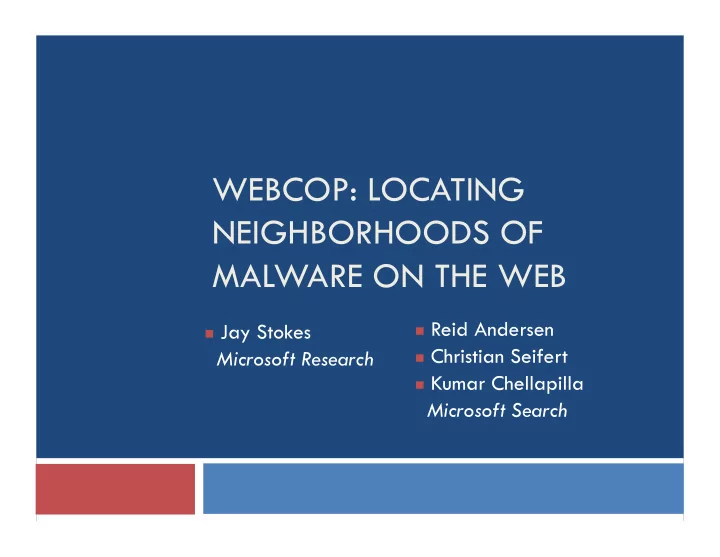

WEBCOP: LOCATING NEIGHBORHOODS OF MALWARE ON THE WEB Reid Andersen Jay Stokes Christian Seifert Microsoft Research Kumar Chellapilla Microsoft Search
Detecting Malicious Web Pages
Detecting Malicious Web Pages
Production System Drive-By Download Malware is automatically downloaded No user interaction Strider HoneyMonkey (Wang 2006) Top-Down Approach Obfuscated JavaScript redirections Other notable work (Moshchuk 2006, Provos 2007, 2008)
Drive-by Detection Limitations Difficult to identify suspicious pages to scan Production system looks for changes after running malware in a virtual machine Attackers adapt and learn to avoid detection Malware will often detect it is running in a VM Halt execution Centrally Located Service
Top-Down with Crawler Moshchuk 2006, Stamminger 2009 Crawl the web Direct Links Download and test executables AM Scan
Top-Down Crawling Limitations Downloading all executables from the internet is problematic Need to simulate user input Installation, web surfing Scanning with an AM engine May require full system scan (Stamminger 2009) To avoid reimaging, test in a VM Again, malware can detect VM and hide Centrally located service
WebCop Solution Bottom-Up Approach Anti-Malware reports indicate malware distribution pages Crawler discovers all web pages linking to the malware Direct Links Additional Goal: Identify neighborhoods of malware on the web
WebCop System
WebCop Advantages WebCop only deals with hard classifications Distributed worldwide sensor network Millions of clients Targeted detection AM service detects malware running on native OS Not in a VM Malware will not try to hide Users input all UI interactions
Telemetry Reports Automatically submitted to backend File is downloaded from internet Malware detection Unknown file was not signed by a trusted entity Reports include Distribution page URL File Hash Most recent 1 million distinct labeled URLs through end of May 2009 837,882 Malware URLs 162,118 Benign URLs Telemetry reports from a URL are usually only seen during a one month period Only 8.7% overlap of malicious distribution URLs between April and May, 2009
Occurrences of Executables
Link Analysis Web graph from June 1, 2009 Measure Count Number of 10,853 Intersecting distribution intersecting pages malware distribution pages Occurs in both AM Number of malware 391,893 reports and web graph landing pages
Median Malware Topologies LP LP LP LP LP 2984 2498 DP DP Single Edge Fan-In LP LP LP LP LP LP 388 547 DP DP DP DP DP Fan-Out Complex
Malware Subgraph Statistics Measure Topology Median Average Number Fan-In 4 31.3 Landing Pages Complex 5 33.7 Number Fan-Out 2 3.5 Distribution Pages Complex 3 4.9 Number Fan-In 4 31.3 Edges Fan-Out 2 2.9 Complex 11 72.2
Comparison with Production System Drive-by detections from April 6 – June 1, 2009 Little overlap 2 matching distribution pages 0 matching landing pages Complementary to current production system Lists can be combined
Locating Potential New Malware Neighborhood graph Unknown distribution pages (UDP) Identified 346,084 unknown MLP distribution pages 32 suspicious pages for each labeled malware pages Suspicious Executables MDP UDP Download and scan More sophisticated automated analysis Unknown Executable Two-Hops Rank for analysts Away from Malware
HostName Impurity How often do landing and distribution pages share same hostname? HostName impurity score w j - fraction of nodes sharing same hostname Low score, most nodes in neighborhood share same hostname
Discover AM False Positives Use graph topology In-Degree Total number of edges where node is the head Malware distribution page with 540K links Distribution Page Number
Will WebCop Work in Production? Telemetry Malicious Malicious Queues of distribution Reports Intersecting Landing pages (e.g. 2 or 3 Distribution Pages Pages months) May 2009 2,763 158,333 Telemetry reports only Only March – 4,633 212,688 seen for a short time May, 2009 Find large number of Most Recent 10,853 391,893 One Million new landing pages Reports each month
Conclusions WebCop provides Targeted, bottom-up approach for detecting malware landing pages on the internet Large scale evaluation of malicious internet neighborhoods composed of direct links New way to detect false positives in an AM service using the internet web graph New method to discover potential malware
WEBCOP: LOCATING NEIGHBORHOODS OF MALWARE ON THE WEB Reid Andersen Jay Stokes Christian Seifert Microsoft Research Kumar Chellapilla Microsoft Search
Microsoft Security Essentials Privacy Statement “…, by accepting this privacy statement, you agree to send reports to Microsoft” “… reports include information about … cryptographic hash, ...” “… might collect full URLs ...”
Recommend
More recommend